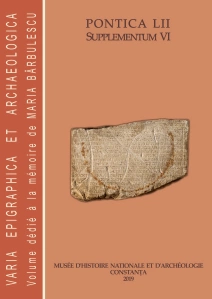Ab Axiupoli VI milia passuum. Cetatea romană de la Seimenii Mari
Ab Axiupoli VI milia passuum. The Roman Fort at Seimenii Mari
Author(s): Ioan Carol OprișSubject(s): History, Anthropology, Social Sciences, Archaeology, Local History / Microhistory, Ancient World
Published by: Muzeul de Istorie Națională și Arheologie Constanța
Keywords: Seimenii Mari; Domneasca Mare lake; miliaria; L. Iulius Statilius Severus; C. Ovinius Tertullus; Roman fort; Tetrarchic inscription; watchtower;
Summary/Abstract: Our paper presents all modern historical sources and maps available mentioning the Roman Fort at the southern limit of Seimenii Mari village (Constanța County), on a 60 ha plateau next to the Danube. The first professional visitor of the site was Pamfil Polonic, most likely during his intensive activity for over one decade at the National Museum of Antiquities (1892-1902), under the direction of Grigore Tocilescu. He drew up a site plan of the plateau and left relevant information regarding a recently discovered Romanfort destroyed by the river, the position of a second watchtower and of a civil settlement surrounded by a vallum and ditch defensive system. The ”large” Roman fort had a rectangular (square?) shape with sides of at least 80 m (i.e. the measured length of the eastern wall, not long before Polonic's visit); the watchtower was subsequent and had a 20 m long eastern side, with northern and southern walls partially preserved. One of the unresolved issues is the one regarding the dating of the civil settlement, the vallum and the ditch enclosure: Pamfil Polonic, Grigore Florescu and most of the Romanian historiography assigned it to the Roman epoch; K. Škorpil, on the other hand, briefly formulated the hypothesis of an Early Bulgar fortified settlement and he was followed by S. Torbatov. Sinceno archaeological investigation followed after the short campaign of Gr. Florescu at Seimeni(1924), it is impossible for the moment to formulate a relevant answer. Cartographic sources were also an essential part of our approach, namely Charta României Meridionale/ Map of Southern Romania (1864), also known as The Szatmari Map, Jakob Weiss' map (dated 1911)or the Romanian Military Maps, ”Planurile Directoare de Tragere”, drafted at a 1: 20000scale after World War I, with the short notice ”La cetate”/ „At the Citadel”. Mapping the numismatic evidence at Seimenii Mari, Seimenii Mici and the surrounding area might also help us understand the anthropic habitation, well attested after emperor Aurelian until the Hunic raids in the 5th century and once again during Justinian (538/539) and Tiberius II Constantine (580/581). Both older and more recent surveys carried out along the Siliștea Valley (with the Domneasca Mare and Domneasca Mică lakes) and the successive Purcăreți,Ramazan (or Ramadan) and Țibrinu Lakes, unveiled numerous Hallstatt (Babadag I), Latène, to Early and Late Roman, Romano-Byzantine and Middle Byzantine (Dridu) habitation sites in the area between the Danube and the tributary valleys. Last but not least, epigraphy is essential for the accurate mapping of the Roman fortified site at Seimenii Mari. It stood along the limes road (via militaris), precisely six miles (or 6000 paces) from Axiopolis, according to the two preserved milestones found in the civil settlement and dating back to the last year of Antoninus Pius (AD 160) and the reign of Septimius Severus (AD 200), under governors L. Iulius Statilius Severus and C. Ovinius Tertullus. A Tetrarchic "Bauinschrift" dated 293-305 from Seimenii Mari belongs to a Lower Danube series (Zernes/ Donje Butorke, Sexaginta Prista/ Ruse, Transmarisca/ Tutrakan, Durostorum/ Silistra and Halmyris/Murighiol), attesting the (re)construction of the local burgus/ praesidium.
Journal: Pontica
- Issue Year: VI/2019
- Issue No: 52
- Page Range: 271-290
- Page Count: 20
- Language: Romanian

